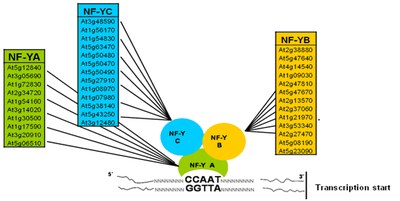Transcription control during abiotic stress: The NF-Y transcription factor family
Exploration of properties and functions of specific members of the NF-Y family for gene activation during adaptation to environmental stress
Dieter Hackenberg, Yanfang Wu
The eukaryotic transcription factor NF-Y (nuclear factor Y) acts as a heterotrimeric complex in the transcription initiation and repression of CCAAT box-comprising promoters. While in mammals and yeast each subunit is encoded by a single gene, plants possess multiple gene families for each subunit. In Arabidopsis thaliana the three subunits NF-YA, B and C are encoded by 10, 13 and 13 genes, respectively. Detailed transcriptional analysis by RT-PCR for all 36 members during various stress conditions revealed differential expression patterns of single NF-Y genes in different tissues, during stress and plant development. It is hypothesized that specific tasks are attributed to plant NF-Ys during development and environmental stress. These tasks are achieved by the function-dependent combinatorial assembly of individual subunits to NF-Y and subsequent binding to CCAAT-boxes of specific genes. Our main objective is to elucidate functions of NF-Y subunits for the adaptability to different environmental stresses.

Project 1
Assembly and subcellular translocation of specific members of the Arabidopsis NF-Y transcription factor complex
The eukaryotic transcription factor NF-Y acts as a heterotrimeric complex in the transcription initiation of CCAAT box containing promoters. It is hypothesized that specific combinations of always one member of each subunit family form individual functional NF-Y complexes. Using a high-throughput yeast-two-hybrid approach, the bilateral interactions among single NF-Y subunits were analysed. Using GFP fusion constructs, NF-YA and NF-YC localisation in the nucleus was demonstrated, while NF-YB is imported into the nucleus only as a heterodimer associated with NF-YC. This piggy back transport of two subunits differs from the import of the NF-Y heterotrimer of heterotrophic organisms. A redox-controlled NF-YB dimerization could not be confirmed for the Arabidopsis homologues. In silico modelling as well as in vivo studies indicate that no disulfide bonds exist among intra- or intermolecular conserved cysteine residues of plant NF-YB.
Project 2
Function and expression of Arabidopsis NF-Y subunits in response to abiotic Stress and for the induction of flowering
The transcription factor NF-Y consists of the three subunits A, B and C, which are encoded in Arabidopsis in large gene families. The multiplicity of the genes implies that NF-Y may act in diverse combinations of each subunit for the transcriptional control. We aim to assign functions in stress response and plant development to NF-Y subunits by analyzing the expression of NF-Y genes and exploitation of nf-y mutants. This reverse genetic approach for NF-Y mutant genes revealed a number of phenotypical changes, including increased stress sensitivity to drought and salt stress or early flowering.

Publications
Hackenberg D, Wu Y, Voigt A, Adams R, Schramm P and Grimm B (2012) Studies on differential nuclear translocation mechanism and assembly of the three subunits of the Arabidopsis thaliana transcription factor NF-Y. Mol Plant 5 (4): 876-888
Hackenberg D, Keetman U and Grimm B (2012) Homologous NF-YC2 Subunit from Arabidopsis and Tobacco Is Activated by Photooxidative Stress and Induces Flowering. International Journal of Molecular Sciences 13(3): 3458-3477
Hackenberg D and Grimm (2012) Technical note – High-throughput analysis of bilateral protein-protein interactions using the yeast two hybrid system. J of Endocytobiosis and Cell Research 6-1